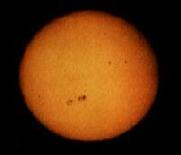


 Sunspots: More Than What Meets the Eye
Sunspots: More Than What Meets the Eye

Discover various characteristics of the Sun using daily net-accessible images from the SOHO spacecraft. Different activities allow students to record the nature and behavior of sunspots, determine the rotation rate of the Sun by tracking sunspots, explore the sunspot cycle, determine whether sunspots are indeed features of the Sun, and predict the reoccurrence of sunspots as they move around the solar disk. Students also learn to make their own "pinhole" camera for observing the Sun.
Advanced students can examine the correspondence among various wavelength images and explore the nature of the Sun further.

 FOR THE TEACHER
FOR THE TEACHER

 View today's Sun and take data.
View today's Sun and take data.
 Do the sunspots move?
Do the sunspots move?
 Sunspot races -- place your bets!
Sunspot races -- place your bets!
 Do sunspots have a pattern, a cycle?
Do sunspots have a pattern, a cycle?
 Are the sunspots really on the Sun?
Are the sunspots really on the Sun?
 Sunspots -- Test your Knowledge!
Sunspots -- Test your Knowledge!
 How can you (safely) observe the Sun yourself?
How can you (safely) observe the Sun yourself?
 What does the Sun look like in other wavelengths?
What does the Sun look like in other wavelengths?

 Does the Sun Spin?
Does the Sun Spin?
(An alternate sun rotation activity, developed by
the Center for Extreme Ultraviolet Astrophysics, UC Berkeley)

 Want to know more about the history of studing sunspots?
Want to know more about the history of studing sunspots?
![]() A wonderful overview of the life and work of Galileo Galilei
A wonderful overview of the life and work of Galileo Galilei
We should have a few more directly-related sites here, so they can go further.

For more information about the Sun and helioseismology in general, see Stanford's Wilcox Solar Observatory, [others?]To explore solar images in visible, xray, hydrogen-a, and calcium wavelengths, as well as find other information about solar observing, see the Solar and Heliospheric Observatory HomepageFor historical solar data, explore NOAA archives.

Comments?
For more information about the Center, email outreach@solar.stanford.edu.
Author: Deborah Scherrer deborah@quake.stanford.edu
Last revised: February 10, 1997 by DKS
Current page access count =